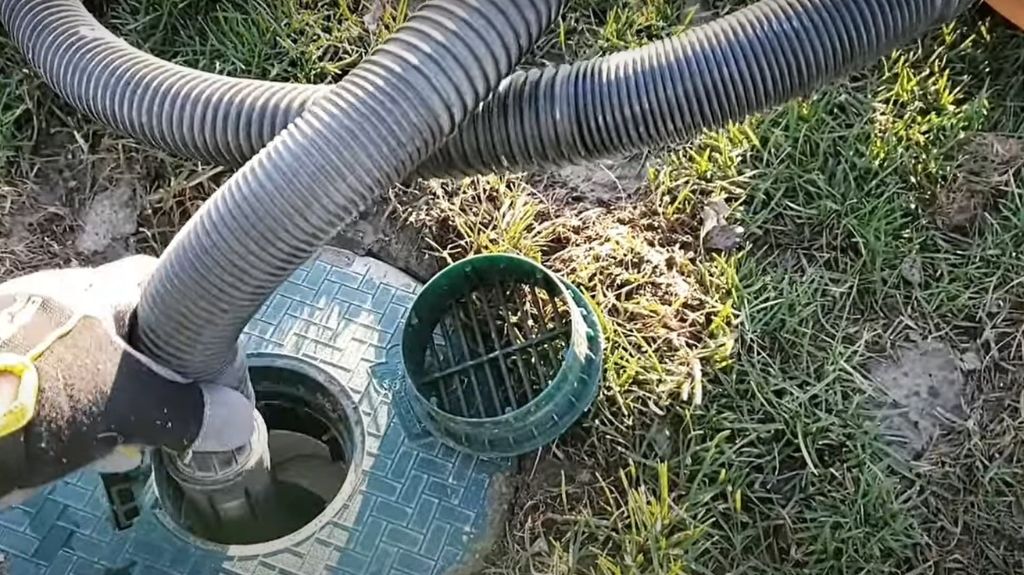This is What’s Making Your Basement Flood
I’m going to talk about all the things that cause a flooded basement or a flooded crawl space. These are the top issues that result in a wet basement, mold, and mildew issues along the house. Here’s why basements flood and how to avoid it.
Downspouts Too Close to the House
Let’s start with the downspout. Too many times, people make excuses as to why they can’t get the water away from the house. I understand that sometimes there’s a sidewalk there. Sometimes homeowners built a structure and didn’t think ahead. But downspouts need to run further away from the house. For example, you can’t leave your downspout in a landscape bed by the house. Whether you have to lift a piece of concrete out, cut a piece of concrete out, or remove brick pavers and a retaining wall, the effort is well worth it for a dry basement or dry crawl space without mold and mildew.
No Inline Catch Basin

Another reason why basements flood is because homeowners don’t have easy access to their buried downspout to clear out debris.
Always install an inline catch basin to access your buried downspout. Yearly, you want to go inside your system and clean it out. What does that mean? Pop that little grate off the top and vacuum it with a wet/dry vac. It’s a super simple and easy process.
Then with a pop-up like we have, you have access to an easy clean-out option. You can now run the garden hose up the line and flush out any debris that may fill the drain pipe down to the pop-up. Again, it’s super easy to let the water soak away. You’re letting the water soak away, vacuuming the line, or picking the debris out with your hands.
Leaky Roof and Gutters
Gutters that are leaking or coming apart can result in drainage problems for homeowners. Even if you need to ask a friend for some help, you have to take sealant and seal those leaks up. You can get that sealant at any big box store.
Next, we always encourage you to build gutters with a clean-out. If you have a clean-out up at the house, running a garden hose down the line through the inline catch basin and right down to the pop-up emitter is super easy. Think about it. Now you have three places to access this line and two places to clean it out.

If you have an older asphalt shingle roof, you will need to take that wet/dry vac and clean out your inline catch basin more frequently. I can’t emphasize this enough. As your roof ages, the shingles break down and deteriorate. The shingle gravel starts to come off after years gone by at an alarming rate. I can’t even begin to tell you how much shingle gravel we find in these systems. You just want to pop that little grate and vacuum the line. After vacuuming, chase more shingle gravel out by putting a garden hose in a clean-out. Always start by vacuuming it out. You’ll have a ton of gravel in the inline catch basin. That’s its job.
Grass Growing Over the Discharge Line
The number one reason why basements flood is that grass grows over the discharge area of the downspout.
If that water can’t leech away, your buried downspout can’t do its job correctly, and homeowners will have drainage issues.
French Drain man designed a pop-up emitter with a turf restrictor plate to combat this. That turf restrictor plate prevents grass or other vegetation from growing over the pop-up. We designed our pop-up emitter V2.0 to be easy to maintain for homeowners. If you need to take it apart due to branches, leaves, or debris getting caught during low-volume rains, you can easily do so.
The Importance of Understanding Why Basements Flood
Understanding why basements flood and how to avoid it can save you time and money down the line. Moving downspouts further away from the house, installing inline catch basins, sealing leaky roofs and gutters, and installing a pop up emitter with a turf restrictor plate can prevent those problems before they start. Instead of paying costly repairs to your basement, these simple tips can ensure that your basement and foundation stay dry.
